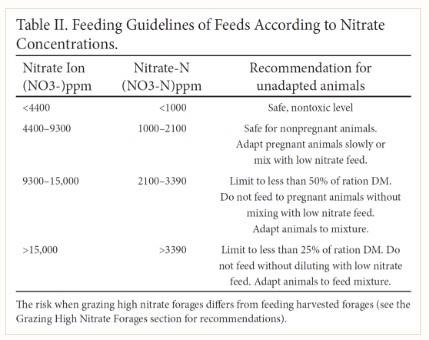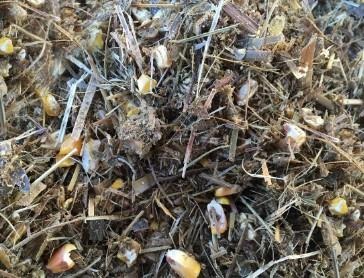By Brad Schick and Mary Drewnoski et.al
Many areas of Nebraska and surrounding states are experiencing drought and lack of water for irrigation. What are the alternatives and considerations when grain harvest won’t be a viable option?
When harvesting drought-stressed corn to feed, consider:

- Insurance. First, before any actions are taken, file a claim and discuss the options with your crop insurance agent on what is permitted, as well as what strips need to be left.
- Chemical labels. Another important item is to check the labels of any chemicals applied to the corn and look for any grazing, haying, or pre-harvesting restrictions if it is to be used for livestock feed. The "Forage, Feed, and Grazing Restrictions for Row Crop Herbicides" portion of the Guide for Weed, Insect, Disease Management for Nebraska provides some guidance from labels on pages 212-216.
- Nitrate poisoning potential. Drought conditions can prevent normal plant growth, thereby higher levels of nitrates can accumulate in the cornstalk. Nitrates outcompete oxygen in an animal’s hemoglobin and can cause suffocation or even lead to death. Livestock do convert nitrate to other nitrogen compounds in the rumen, but it is the amount consumed and time it took to consume the forage that become the issue. If deciding what method to create feed, remember that typical dry haying does not reduce the nitrate level. However, silage — or any ensiling process, such as baleage — can reduce the level of nitrates 20-50%. The lower portion of the plant contains the highest concentration of nitrates. Do NOT harvest for at least three days following rain that “breaks” drought conditions. The rain causes an uptake of nitrogen from the soil, which is translocated into the plant. After three days, the nitrogen will have been converted to plant protein and is no longer in dangerous form. When feeding forages with higher nitrates, be sure to dilute with other feeds to reach safe feeding levels. Levels of safety are included from the table below from NebGuide G1779 Nitrates in Livestock Feeding.
- Testing for Nitrates. The cost for nitrate testing is generally very inexpensive and worth the cost. Take multiple samples from various portions of the field to see if there are areas of the field where nitrates are higher. When sampling, mix the grab-samples and sub-sample an amount to fill a plastic bag that can be sealed at the top. Compress the air out of the bag and seal. Samples should be frozen between days or whenever kept in storage. For more information, please see NebGuide G1779.
When harvesting drought-stressed corn as forage, consider these options:
 Figure 1. Drought-stressed corn silage will contain lower levels of grain than normal corn silage. (Photo by Kristen Ulmer)
Figure 1. Drought-stressed corn silage will contain lower levels of grain than normal corn silage. (Photo by Kristen Ulmer)- Moisture. For hay, moisture content needs to be about 15%. High humidity during the summer creates a long dry-down period. Baleage moisture content should be 45-55% while a typical packed silage should have a moisture content of 65-70%. A noteworthy consideration is that moisture content will likely be higher than expected even though the corn looks “dry,” so checking moisture is critical for proper storage and to reduce the risk of combustion and spoilage.
- Haying. If corn grain is minimal on drought-stressed plants and silage is not an option, baling the corn stover for feed is a final opportunity. Cut the stover at eight to 10 inches above the ground when a little green tissue is present and allow to dry down to stover for baling. Drying may take seven to 10 days. Nitrates still exist in the corn stover and do not decline as it does in the ensiling process, so caution should be used when feeding. Sending in a sample prior to harvest will allow an initial look at nitrate levels. If nitrate test comes back high and at a dangerous level, cut the plants higher, eight to 12 inches off the ground.
- Baleage. Baleage is partially dried forage (45-55% DM), which is baled and wrapped with at least six layers of 1 mil plastic. When cutting, leave at least eight inches of stalk to avoid higher nitrate concentrations there. Baleage will likely need to be wilted for several hours to reach the correct and safe moisture content.
- Silage. This method is the most widely preferred as the ensiling process reduces nitrate levels by as much as one-half to one-third as the gas escapes as nitrous oxide compounds from the pile. Leave at least six to eight inches of stalk. Monitor moisture content to be 65-70%. Due to a lack of grain compared to typical silage, fermentation will be different. The use of an inoculant is a good risk management tool to ensure a higher quality silage and lack of spoilage.
- Proper ensiling technique is the key to success. Following are several articles on properly ensiling corn silage. Also see the UNL BeefWatch article “Silage Considerations.” Before using the silage in a ration, it's a good idea to test it for moisture, crude protein, TDN and nitrate content to allow for proper formulation in a ration. Tips for obtaining a good sample are provided in the NebGuide, Sampling Feed for Analyses. YouTube videos from the Silage for Beef Cattle Conference will provide more in-depth information on producing and using corn silage in cattle rations.
- Grazing. If grazing drought-stressed corn, limit access to the field from both a grain and nitrate risk standpoint. This means using strip grazing. Adapt cattle to grain by feeding two to three pounds per day and slowly move up to 10-15 pounds per day over approximately 10-14 days. Seasoned cows will seek out the corn ears before forage, meaning the cow will have a high grain diet and an increased risk of acidosis. Turn cattle out that are full and make sure plenty of fresh water is readily available. If the level of nitrates is known in the field, start with the lowest areas of the field and work into the higher nitrate areas later. Providing poloxalene, or bloat blocks, is another safety measure. Also consider feeding high quality hay as a supplement and then moving to the corn field for a period of time during the day.
- Cross fencing and strip grazing areas will help limit intake and reduce trampling while turned out on drought-stressed corn. Recall nitrates are an issue with higher concentrations noted as you move from top to bottom of the plant. Do not force cattle to eat lower portion of stalk, as that is where highest concentration of nitrates exist. See the UNL article "Graze Drought Stressed Cornstalks CAREFULLY" for more information on grazing.
- Feeding green. Green chop is chopping corn and feeding it fresh instead of first letting it go through an ensiling process. Nitrates accumulate in the lower eight to 12 inches of the standing cornstalk in drought-challenged corn. Setting the cutter bar higher and chopping the corn for green chop may lower the amount of nitrate fed. If feeding green chop, feed immediately after harvest and only feed the amount that the animals will consume in two hours. If green chop is left in the bunk or on the wagon, it can heat up and nitrate will be converted to nitrite. Nitrite is 10 times as toxic as nitrate when fed to animals. Therefore, it is better to feed green chop two to three times a day to ensure that it is cleaned up quickly and not left sitting.
- Also, ensure that there is plenty of bunk space — about 36 inches of space per cow — so the boss cows do not overeat and timid cows are allowed to eat their share. If nitrate poisoning is suspected, remove the contaminated feed from the diet, provide a high energy feed such as corn grain, and call a veterinarian immediately. Green chop may be a potential alternative for feeding some drought-stressed corn, but one should do so with care.
Options exist for utilizing drought-stressed corn, but one must look at his/her scenario to determine which situation would work well with the risk taken. Drought-stressed corn can be utilized in several ways with careful management and care in feeding.
Source : unl.edu